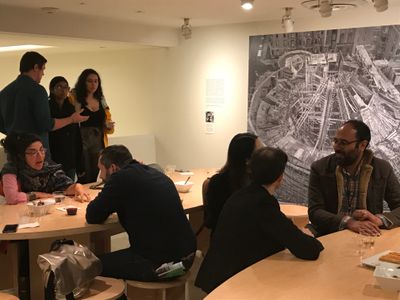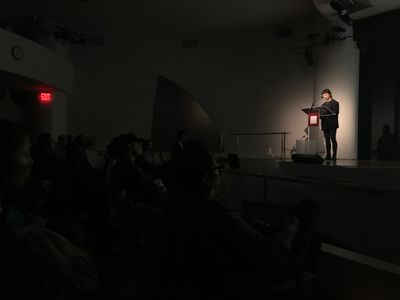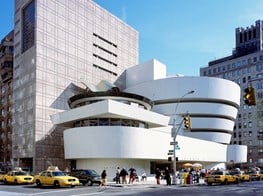Asia Contemporary Art Week: Diary #3: 23–29 September 2018
In collaboration with Asia Contemporary Art Week
In this third week of ACAW, which offered the continuing opportunity to engage in 'thinking collections' through the lens of Asian arts practitioners in the city, the identity of collecting and collections found its own centrifugal force, with a fusion, proliferation and collision of ideas. Chen Dongfan and Cyoko Tamai's open studios offered the opportunity to reflect on 'more is more and less is more' in practice, while presenters at the Solomon R Guggenheim Museum's 'Technology is History' symposium spoke to the direction a particular construct will travel in and the life it takes on as it moves forward. The closing reception at the Sylvia Wald and Po Kim Art Gallery merged decades-long inquiry into projected futures in A Time Before We Were Born: Visions of Arcadia in Contemporary Painting (26 June-29 September).
Chen Dongfan, 'Thinking Collections: Open Studios', Artist Studio, Long Island City, Queens, New York (23 September 2018). Courtesy Asia Contemporary Art Week.
Cyoko Tamai's temporary studio experience courtesy of host Ronin Gallery in Midtown allowed visitors to understand more deeply the evolution of her work as a process of deconstruction and extraordinary labour on a minute scale. Her pieces hang like works on paper but read like sculptures—nebulous, voluminous forms that appear to float or rise out of the surface. Using only a steel headed stylus and black sumi ink on traditional washi paper (made by Japanese living national treasure Sajio Hamada) Tamai dips the tip of the stylus and undertakes a series of deft pulling motions, separating the delicate threads of paper, motioning them upwards and outwards into feathered structures that absorb the dense ink. David Taro Libertson, owner of the Ronin Gallery, explained that when he first observed her working on the paper as part of her residency at Japan Society, she was attempting to separate and ink each individual thread, and that this technique was born out of a willing acquiescence to a new way of working. The results are like bird's-eye views of subterranean worlds—ink-blotted fibres that fuse to form floating shapes and prisms.
The Solomon R Guggenheim Museum's day-long 'Technology is History' symposium took place on Friday 28 September. The event was co-organised by curator Xiaoyu Weng and Brian Kuan Wood and functioned as a performance and lecture platform for key practitioners in the art-technology space in conjunction with the exhibition One Hand Clapping (3 May–21 October 2019), which considers the future in light of globalisation. The day opened with a keynote by philosopher Yuk Hui (a contributor to the One Hand Clapping catalogue), and concluded with an after-hours exhibition viewing session.
Ho Rui An, as measured and in good humour as ever, spoke over a silent 19-minute video of a coin balanced on the windowsill of a high-speed train—footage he shot himself in China where he pilgrimaged to make it after discovering a dash cam recording's wormhole of 'coin tests' on high speed trains. He notes that the coin is more often than not a sturdy two-euro, and uses this motif as an entry point into a political economy of imagined symbolism. 'Does this European coin standing precariously on its edge imply that capitalism is going off the rails?' China, in any state of affairs, can be indicted on the charge of lacking in capitalism, and perceived as incomplete in its journey toward Western capitalist modernity. 'Even if China does progress', postures Ho rhetorically, 'it does so in its own evolution, pressing on in its necessary drive toward the end of history'.
Liu Chuang presented a flawlessly edited first screening of a three-channel film, Bitcoin Mining and Field Recordings of Ethnic Minorities, while Dawn Chan considered the real-life applications of wrap-around gaming worlds in terms of power, imperialism and liminality. A 'wrap-around world', she explained, 'is an entirely imagined representational idea of space', where something can exit on one side and re-emerge instantly on the other (citing Pac-Man). She asked, 'is this a generative model that we could use to discuss other relationships?' With particular reference to a Ghandi character in Civilisations who oscillates between pacifist and warmonger, she asks if it is possible to conceive of a reality where 'two introverts wrap around and form rhizomatic relationships, or where increasing isolation suddenly become extreme connectedness'.
In his short film Parallel Narratives (2015–2017), Francisco Camacho Herrera postured that 'there is no universal ideal of what it means to be part of a culture'. Gala Porras-Kim, in a beautifully humble and increasingly agitated address, stated 'I want to prepare to know something I don't know' and asked what will happen when 'today's historical truth is completely dismantled'. Cycling through monumental cultures and a self-perpetuating narrative that keeps our appetites whet for archaeological mythology, when the bounds of technology to 'find everything' have been exhausted, she suggested a circular return to indigenous knowledge. 'Technology is handicapping us, because we ignore native knowledge—will we loop back to other modes of learning and therefore a more democratic historical past', she asked.
Jesse Lerner's 1999 film Ruins—a pastiche montage of mid-20th-century culture and travel documentaries—announced in one segment that 'there is a God dying in America'. Divine, anarchical maxims were burned or scratched over celluloid scenes of endless highway while a narrator commenting on the market for pre-Colombian artefacts in Mexico reminded us that 'transformations and multiples bring us closer to the original object. One forger documented in the piece has come full circle and now works at an anthropology institute dating and verifying artefacts. Reza Negarestani hypothesised in his presentation that 'human history is a machine log', questioning our ability to understand history outside of the accomplishments of Homo sapiens.
At the Sylvia Wald and Po Kim Art Gallery, the group exhibition A Time Before We Were Born: Visions of Arcadia in Contemporary Painting closed after its summer run. Curated by Raphael Rubinstein, the show was rich in Kim's work from the 1970s and 1980s. Included was the gently unsettling Contemplation 1 (2004) diptych, where figure and ground coexist at a halfway point between representational still life and symbolic landscape. It also brought together the work of 13 other artists—including Donna Moylan, Paul Georges and Archie Rand—with much work made in the 1980s in a rare combination lacking the usual aggression and bravado that characterises so much work from the era.
As Asia Contemporary Art Week moves into October, this stage is characterised by an exploration of facts and fictions, tests of temporality, and a 'who made whom' questioning of end-products and end-points. —[O]













































































































































































